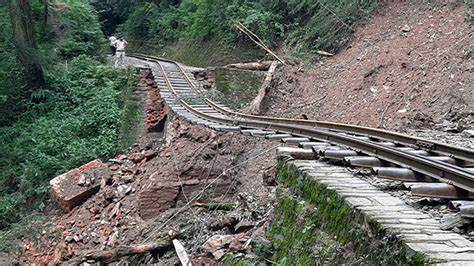The newly-constructed railway station in Kawnpui has collapsed following severe rainfall in the region. The unexpected collapse of this critical infrastructure has raised concerns about the state of construction and the impact of extreme weather conditions on such projects. The incident has led to a flurry of activity from both state authorities and the Indian Railways, as they scramble to address the aftermath and investigate the causes behind the structural failure.
Heavy Rains Trigger Collapse
Mizoram has been experiencing intense rainfall over the past few weeks, a consequence of the monsoon season that has battered many parts of northeastern India. The heavy rains, combined with a series of recent storms, have caused widespread flooding and landslides across the region. The situation in Kawnpui, a town in the Mamit district, has been particularly dire, with the relentless downpour exacerbating existing vulnerabilities in infrastructure.
The railway station, which had been recently completed as part of efforts to enhance connectivity in the region, was severely damaged when its structure gave way under the weight of the rain-soaked soil and unstable foundation. The collapse has resulted in the destruction of several key parts of the station, including the platform and parts of the building, leaving a significant mess of debris and rubble.
Immediate Response and Impact
Upon learning of the collapse, local authorities, along with officials from the Indian Railways, launched an immediate response to assess the damage and ensure the safety of those affected. Fortunately, the incident occurred during a period when the station was not in use, so there were no casualties reported. However, the destruction has significantly disrupted local transportation services, which are crucial for both daily commuters and the movement of goods.
Emergency teams have been deployed to the site to clear the debris and conduct a thorough investigation into the cause of the collapse. Preliminary reports suggest that the excessive rainfall may have compromised the structural integrity of the newly-constructed station, but a detailed assessment is required to determine the exact reasons behind the failure.
The collapse has also raised questions about the quality of construction and whether proper measures were taken to account for the region’s susceptibility to heavy rains and flooding. The Indian Railways and state authorities are facing mounting pressure to address these concerns and provide answers to the public.
Reactions and Concerns
The collapse of the Kawnpui railway station has drawn widespread criticism from local residents and officials. Many are questioning the adequacy of the construction standards and the supervision of the project. Critics argue that the incident highlights systemic issues in infrastructure development, particularly in regions prone to extreme weather conditions.
Local leaders and community members have voiced their frustration over the lack of preparedness and the apparent oversight in the construction process. “This is a serious issue that needs immediate attention,” said a local council member. “The collapse of the railway station is not just a loss of infrastructure; it’s a setback for our community’s development and connectivity.”
The incident has also sparked a debate about the impact of climate change on infrastructure projects. With increasing frequency and intensity of extreme weather events, there is growing concern about whether existing construction practices are adequately addressing these challenges. Experts argue that there is a need for improved designs and construction techniques that can withstand the effects of severe weather.
Recovery and Future Measures
In response to the collapse, the Indian Railways has promised to expedite the recovery process and ensure that the affected areas are restored as soon as possible. Plans are underway to rebuild the railway station with enhanced measures to prevent similar incidents in the future. The reconstruction effort will include a comprehensive review of the existing infrastructure and the implementation of stronger design standards to ensure resilience against extreme weather.
The state government has also committed to providing assistance to the affected community and addressing any disruptions caused by the collapse. This includes arranging alternative transportation options and supporting local businesses and residents who rely on the railway services.
Looking Ahead
The collapse of the Kawnpui railway station serves as a stark reminder of the challenges faced by infrastructure projects in regions prone to severe weather conditions. As Mizoram and other northeastern states continue to grapple with the impacts of climate change, there is an urgent need for more resilient and adaptable construction practices.
The incident has highlighted the importance of rigorous quality control, proper site assessment, and the integration of climate considerations into infrastructure development. By learning from this experience, authorities and stakeholders can work towards building infrastructure that not only meets immediate needs but also stands the test of time in the face of an increasingly unpredictable climate.
In the aftermath of the collapse, Mizoram is poised to reassess its approach to infrastructure development, with a focus on ensuring that future projects are better equipped to handle the demands of a changing environment. As recovery efforts continue, the goal will be to restore services, rebuild with resilience, and ultimately improve the region’s infrastructure to better serve its communities.




